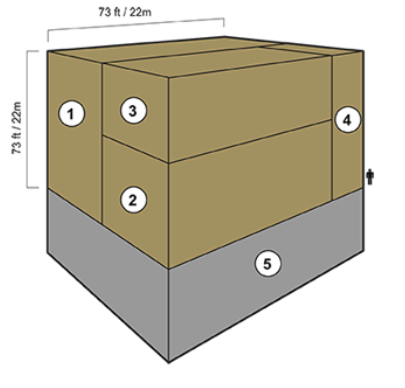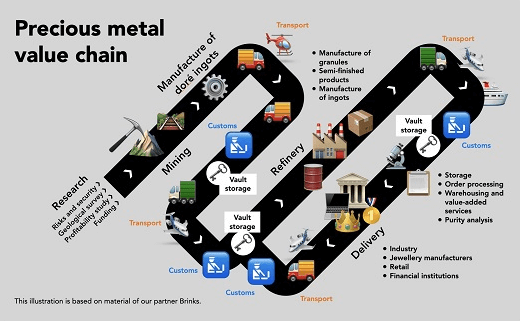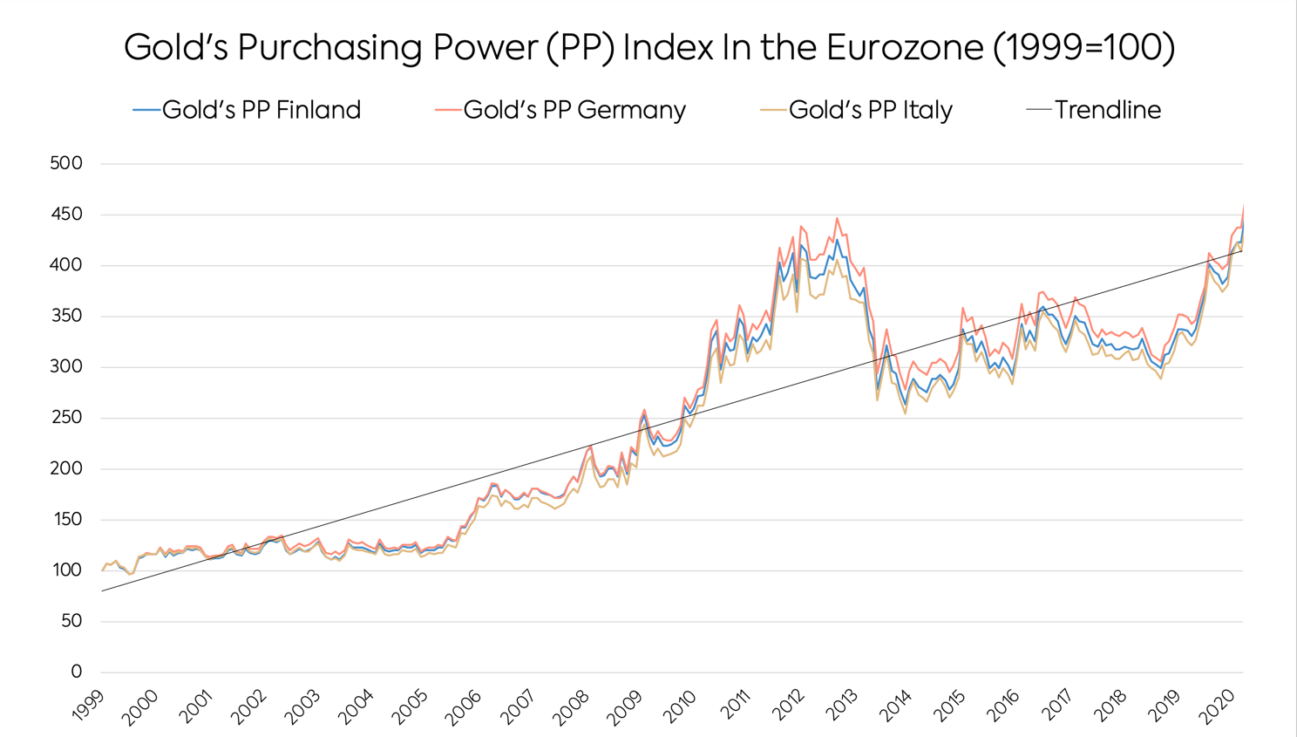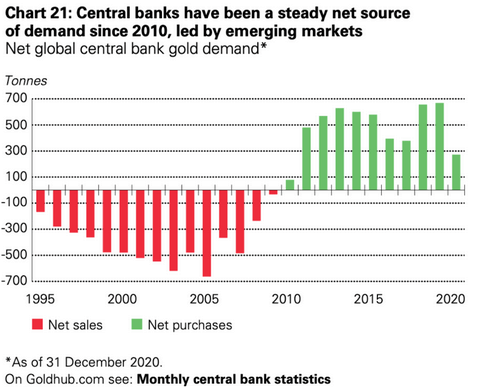Why is gold considered valuable?
Voima
Table of contents
Introduction
It is often said that gold has been a great store of value for thousands of years. But why is gold considered valuable? This article showcases what gold's value consists of, and thus which different factors and actors play a part in making gold something that people want to own and have demand for.
The article will focus more on the value (why something is seen as valuable) rather than the price (what is paid for something) of gold. If you want to read how the price of gold is set in the markets, you should check out Voima's Gold Price page.
Gold is universal
Gold has been valuable throughout written history. One of the seven wonders of the ancient world, the Statue of Zeus at Olympia, was partly made of gold panels. Gold has been esteemed in Asia already in the days of the Shang dynasty and during the second millennium BC in the Andean region—not to mention ancient Egypt! Wealthy rulers have collected golden artifacts throughout the ages, and this has helped the people to associate gold with prosperity and status.
Gold has scattered across the globe, and all the discovered gold still exists in one form or another: all the gold found up to this date could be gathered together in 4.3 Olympic-size swimming pools. (For comparison's sake, a trillion US dollar bills would need 4.5 such pools to fit in.)

The picture above represents the amount of above-gold stocks of gold: 1. jewellery, 2. bars and coins, 3. central banks and 4. others. The section 5. represents the confirmed amount that is yet to be mined; the estimate of World Gold Council is 53,000 tonnes1.
Gold's properties
Chemical properties can be seen as one reason for valuing gold. Gold is an element, so it cannot be destroyed or created, and it is thus both durable and sufficiently rare to store its value. Gold is generally found pure and in a processable state in the ore, whereas most other metals are usually mixed in the ore, which can cause minor difficulties during the smelting process.
Gold is inert, so it does not readily react with other substances, meaning that it does not rust or oxidise for instance. Besides its durability, it is also very malleable and workable, which enables its use for different industrial or aesthetic purposes. Gold reflects light and conducts heat and electricity well. It is also considerably ductile: one ounce of gold can be drawn out to a 80-kilometre long wire. Finally, we should not forget that gold is aesthetically pleasing due to its beautiful and shiny appearance!
Gold's chemical properties enable its working into easily portable and storable forms. The first gold coins came out around 700 BC, and it is easy to imagine how much more convenient it must have been to be able to pay with durable and workable money instead of exchanging crops, cattle or cowrie shells. Gold was also an excellent choice for coins when compared to other many other metals, since unlike bronze, pure gold does not gather patina, nor does it rust or oxidise like iron or steel.
From history to the modern times
At the end of 2021, there were approximately 205 thousand tonnes of gold above ground, according to the World Gold Council. It was distributed as follows:
Above-ground stocks of gold

| Asset class | Share in percentages | Share in tonnes |
|---|---|---|
| Jewellery | 46% | 94,464 tonnes |
| Private investments | 22% | 45,456 tonnes |
| Central banks | 17% | 34,592 tonnes |
| Other | 15% | 30,726 tonnes |
| Total amount | 100% | 205,238 tonnes |
Gold is used especially in jewellery and investments: these segments comprise 85% of the use of the above-ground stocks of gold. The remaining 15% includes for example industrial activities, some of which are covered later in this article.
Gold supply
Since there is demand for gold, there has to be supply for it too. The main body of supply consists of primarily the above-ground stocks: if a person wants to buy 10 grams of gold through their Voima Account, they will get the gold from Voima's vault, which is obviously part of the above-ground stocks. The amount of above-ground stocks is exchanged for the price that market players want to sell it for and for which they find buyers.
In order to increase supply, new gold is mined continuously: if the annual gold production is estimated around 3,000 tonnes, this corresponds to approximately 1.46% of the above-ground stocks of gold. The following table shows how much gold was gained through mine production in 2021:
Mine production of gold
| Country | Production | |
|---|---|---|
| China | 🇨🇳 | 332 tonnes |
| Russia | 🇷🇺 | 331 tonnes |
| Australia | 🇦🇺 | 315 tonnes |
| Canada | 🇨🇦 | 193 tonnes |
| United States | 🇺🇸 | 193 tonnes |
| Ghana | 🇬🇭 | 129 tonnes |
| Mexico | 🇲🇽 | 125 tonnes |
| Indonesia | 🇮🇩 | 118 tonnes |
| Finland | 🇫🇮 | 9 tonnes |
| Sweden | 🇸🇪 | 8 tonnes |
However, there is a limited amount of gold, and mining new gold can be very expensive: insiders in the mining field often cite $1,200 as the cost for one mined gold ounce2. Naturally, there are some local differences, and for instance in Russia, gold was mined for $715 per ounce in 20213. Regardless, finding new gold deposits is growing increasingly difficult, and this will most likely increase the costs of mining.
However, mining costs are just one part of the entire process, through which raw materials make it into a ready product (this process is portrayed by a value chain). The picture below demonstrates, which stages bring more value for gold and other precious metals:

In the case of gold mining, the first stage is to conduct research and studies, which are used to calculate whether the mining would be profitable. Simultaneously, funding opportunities are researched. After this, the mining itself begins, and the mined material is melted into doré ingots, which have impurities mixed in with the gold. Then the gold is transported from the foundries to refineries, from where more pure bars will be shipped onwards.
The majority of the above-ground stocks go from refineries to warehouses and storage, and from there move onwards to recipients such as industrial actors, jewellery manufacturers, retail and financial institutions. Later the gold can end up back to the refineries as recycled gold, thus perpetuating the cycle seen in the picture above.
Gold's ownership and demand
There is demand for gold among individuals, companies and governments alike.
Individuals
Ownership of gold in the East and West
The East values gold even more than the West. In many Eastern countries, it is completely normal to store wealth in the form of gold jewellery, since these serve as a store of value for families, much like an investment. At the same time, gold provides a great alternative for investing, if for example a local bank system or stock exchange has not earned the trust of the citizens4. From this point of view, the behaviour in the East is different from the West, when the gold price fluctuates.
When the price of gold rises globally, the Eastern people usually sell gold in small installments—this can be compared to selling your stocks when they are high. When the price is low, however, the Eastern people simply buy more gold. Besides jewellery, they can buy gold in the form of bars, if for example a company they own has performed well and the price of gold is low enough. If the gold price rises sufficiently, it can then be sold for profit.
In the West, people have been using banking services for decades, and this has caused the Western people to become alienated from the daily use of gold in comparison with the East. In the West, it is not uncommon that some investors remember the value of gold only during monetary crises. In the East, the people have a more lasting trust towards gold: through the ages, they have developed the notion that gold stores its value through generations. This is reflected in the demand trends for gold: the people in the West buy gold more expensive than the people in the East.5
Gold is a true store of purchasing power for private investors
The price of gold rises just like the prices of other products and raw materials as a result of inflation. Because inflation makes the prices go up, this means that the purchasing power of currencies will go down, and so investors often turn to gold in such situations. The gold price development follows the increases in the prices of consumer products, and so gold retains its purchasing power. The data has also proven that gold provides greater risk-adjusted returns for investor portfolios6.
On the other hand, the euro, the dollar and other so-called fiat currencies lose their value as a result of money printing. For example, the euro has lost 85% of its value against gold during the first 20 years of its existence7. This could also be expressed the other way around by stating that gold has strengthened by 550% against the euro. If one adjusts this figure to consumer price inflation, the purchasing power of gold in the eurozone has risen 350% in 20 years.
Below, you can see a graph that shows how purchasing power has developed in the eurozone:

The graph shows that the purchasing power of gold is on an upward trend both in Finland, Germany and Italy.
Central banks

Gold's demand is maintained partly by the central banks: during the last 10 years, central banks have been clear net buyers of gold, which means that they have bought more gold than they have sold.
Below, you can see how much different central banks own gold:
| Country | Gold's ownership in tonnes | |
|---|---|---|
| United States | 🇺🇸 | 8,133 tonnes |
| Germany | 🇩🇪 | 3,354 tonnes |
| Italy | 🇮🇹 | 2,452 tonnes |
| France | 🇫🇷 | 2,436 tonnes |
| Russia | 🇷🇺 | 2,299 tonnes |
| China | 🇨🇳 | 1,948 tonnes |
| Switzerland | 🇨🇭 | 1,040 tonnes |
| Japan | 🇯🇵 | 846 tonnes |
| India | 🇮🇳 | 781 tonnes |
| Netherlands | 🇳🇱 | 612 tonnes |
| Sweden | 🇸🇪 | 126 tonnes |
| Denmark | 🇩🇰 | 66 tonnes |
| Finland8 | 🇫🇮 | 49 tonnes |
| Iceland | 🇮🇸 | 2 tonnes |
| Voima's Customers | 1 tonne | |
| Estonia | 🇪🇪 | 0,25 tonnes |
The websites and publications of central banks can shed light to the rationale why they value gold. For example, the German central bank, Bundesbank, published a book called “Germany's Gold” in 2019: in the foreword, the then-president of Bundesbank Jens Weidmann writes about gold in a very approbatory tone:
Ask anyone in Germany what they associate with gold and, more often than not, they will say that it is synonymous with enduring value and economic prosperity. Ask us at the Bundesbank what our gold holdings mean for us and we will tell you that, first and foremost, they make up a very large share of Germany's reserve assets ... [and they] are a major anchor underpinning confidence in the intrinsic value of the Bundesbank's balance sheet. The Bundesbank produced this publication to give a detailed account, the first of its kind, of how gold has grown in importance over the course of history, first as medium of payment, later as the bedrock of stability for the international monetary system.
Jens Weidmann10
When asked about the reasons for gold ownership, the Bank of England has this to say:
Gold is an important asset of foreign exchange reserves. By providing safe gold custody we are supporting central bank reserve management and thus international financial stability. London is the global centre for gold trading. We support financial stability by providing central banks with access to the liquidity of the London gold market.
Bank of England11
The Bank of Finland says the following about gold:
Gold is called the eternal payment instrument and has been used as a medium of exchange for thousands of years. Gold is a genuinely global means of payment that has maintained its value throughout history. The reasons for this are many, such as gold's rarity, durability, convenience and malleability.
Bank of Finland12
Other uses of gold
As was mentioned before, gold is also used for industrial purposes. Here are a few choice examples of gold's utility in different industries.
Electronics
Since gold conducts electricity well, it is of great use in electronics, especially in cables and connectors. As consumer technology (such as mobile phones) grows more and more every year, there is continuous demand for gold in the industry. In 2021, the demand for gold in the electronic industry was 272 tonnes.13
Space exploration
Gold is used to coat different shields and visors in space exploration, since gold particles reflect the infra-red radiation from the sun. This helps to keep the panel and visor temperatures low. Gold can also be used as a lubricant, since organic lubricants are not as durable in the extreme temperatures and radiation of space.
Medicine
Gold is especially used in the treatment of rheumatism and certain types of cancer. Since gold is non-toxic and it does not react easily with other substances, medicine uses it, for example, as a coating for surgical equipment. At the same time, it has been used in dentistry to build dental bridges and less common prostheses.
Summary
Gold is valued because of its historical status, its properties and its economic performance. It has been a symbol of wealth for a very long time, but at the same time it can be used for useful purposes such as home electronics and dentistry. In terms of economics, gold represents stability both to individuals and central banks, and thus there is demand for gold even today.
All in all, it is justifiable to say that gold will remain valuable for humankind in the future—the reasons for valuing gold are clearly not short term. Today, the ownership of gold has been made very easy, so you too can open a Voima Account and start saving in one of the greatest stores of value in the world.
-
https://www.kitco.com/news/2022-03-21/Lowest-cost-gold-mining-companies-in-2021-report.html ↩
-
Green, Timothy 1987: 'The Prospect for Gold: The View to the Year 2000', p. 133. ↩
-
https://www.voimagold.com/releases/highlights/the-west-east-ebb-and-flood-of-gold/ ↩
-
https://www.gold.org/goldhub/research/investment-update-gold-efficient-hedge ↩
-
https://www.voimagold.com/releases/highlights/since-inception-the-euro-has-devalued-by-85-against-gold/ ↩
-
The Bank of Finland's gold ownership represents 22% of its total financial assets. ↩
-
Apart from Voima's Customers, the ownership figures here refer to central banks. ↩
-
Thiele, Carl-Ludwig 2019: 'Germany's Gold'. ↩
-
https://www.suomenpankki.fi/en/media-and-publications/releases/2008/gold--the-basis-of-a-monetary-system-the-bank-of-finland-museums-newest-seasonal-exhibition/ ↩
